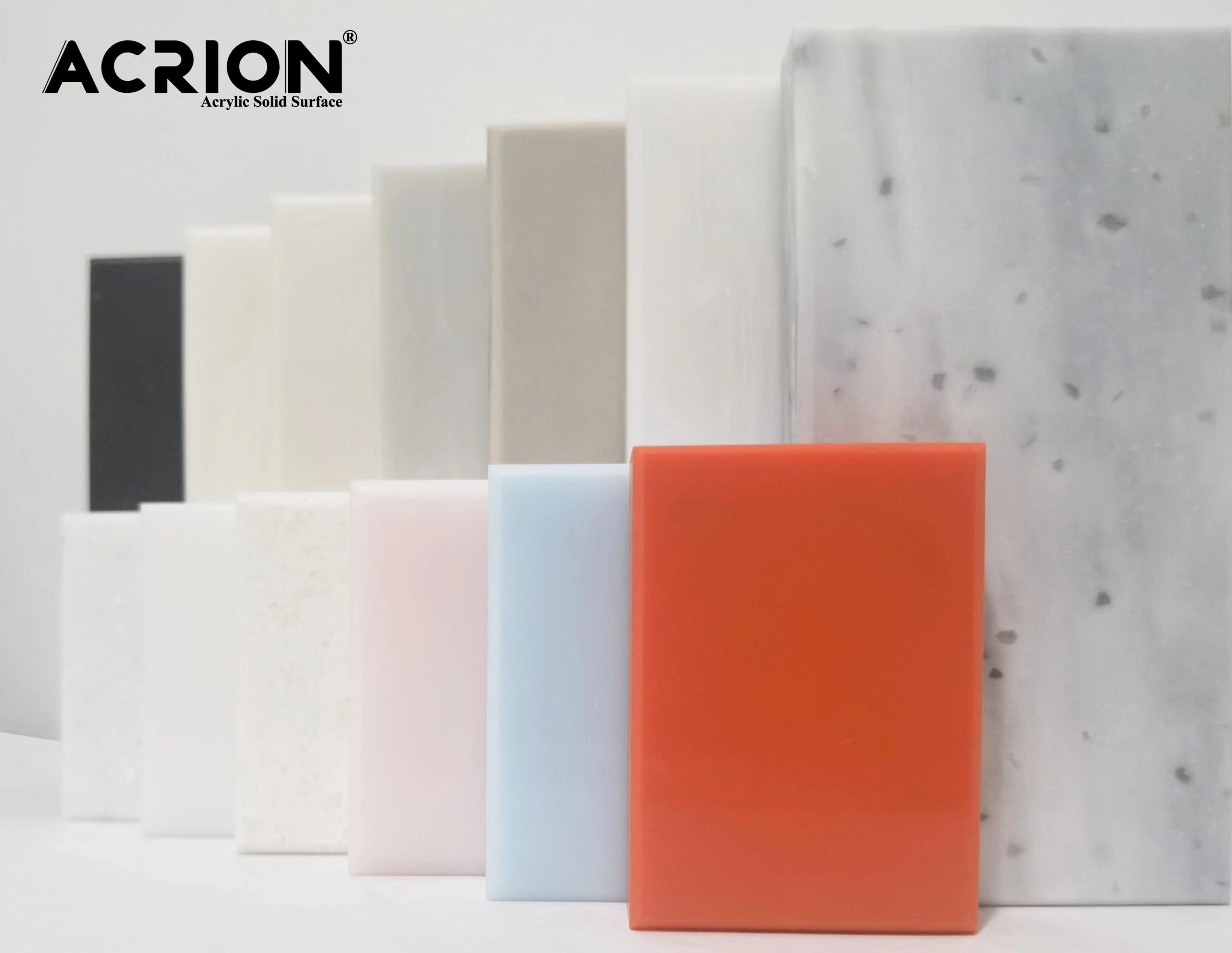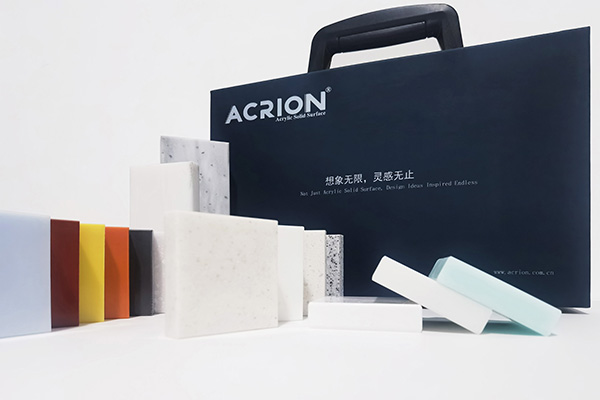Análise de propriedades antibacterianas e antifúngicas na superfície de sólido acrílico
O desempenho antibacteriano e antifúngico da superfície sólida acrílica é influenciado pela tecnologia de modificação da resina, tipos de aditivos e condições ambientais. A análise a seguir é conduzida a partir de três aspectos: mecanismo antibacteriano, desempenho antifúngico e fatores de influência:
Primeiro, as fontes e mecanismos das propriedades antibacterianas
Dopagem com agente antibacteriano
Funções antibacterianas podem ser conferidas ao revestimento através da introdução de agentes antibacterianos inorgânicos (tais como óxido de zinco, íons de prata) ou agentes antibacterianos orgânicos (tais como sais de amônio quaternário) na resina acrílica. Por exemplo, o óxido de zinco pode gerar atividade fotocatalítica sob irradiação de luz ultravioleta, liberando íons de zinco para destruir as membranas celulares das bactérias, inibindo assim a proliferação bacteriana. Experimentos mostram que o revestimento acrílico contendo óxido de zinco ainda pode manter alta atividade antibacteriana após simular o uso diário. A liberação de íons de zinco aumenta significativamente após o tratamento contra desgaste e o efeito antibacteriano fotocatalítico é excelente.
Tecnologia de modificação de superfície
Grupos antibacterianos são introduzidos na superfície da resina acrílica através de enxerto químico ou mistura física. Por exemplo, a mistura de agentes antibacterianos contendo siloxano com resinas acrílicas pode dotar a superfície do revestimento com hidrofobicidade e propriedades antibacterianas, reduzindo a adesão bacteriana. Além disso, a introdução de agentes nano-antibacterianos (como Nano-Silver) pode melhorar ainda mais o desempenho antibacteriano, mas sua dispersibilidade precisa ser controlada para evitar aglomeração.
Antibacteriano ambientalmente responsivo
Alguns revestimentos acrílicos podem desencadear mecanismos antibacterianos através de estímulos ambientais como umidade e luz. Por exemplo, num ambiente húmido, a taxa de libertação do agente antibacteriano no revestimento acelera, aumentando assim o efeito antibacteriano. Esta característica é adequada aos requisitos antibacterianos em ambientes de alta umidade, como banheiros e cozinhas.
Em segundo lugar, o desempenho e os fatores que influenciam o desempenho antimofo
Mecanismo anti-mofo
O desempenho antimofo do revestimento acrílico depende principalmente de sua estrutura superficial densa e baixa taxa de absorção de água. Por exemplo, ao otimizar a fórmula da resina e o processo de cura, a porosidade da superfície do revestimento pode ser reduzida, inibindo assim a adesão e o crescimento de esporos de fungos. Além disso, a adição de fungicidas (como isotiazolinonas) pode potencializar ainda mais o efeito antimofo, mas deve-se atentar para sua compatibilidade com a resina.
A influência das condições ambientais
O crescimento do mofo requer a satisfação de três elementos: umidade, temperatura e substrato nutriente. Por exemplo, em um ambiente com temperatura variando de 25 a 30°C e umidade ≥80%, a taxa de crescimento de mofo acelera significativamente. O revestimento acrílico deve ter boa resistência à água e respirabilidade para evitar que o acúmulo de água na superfície cause o crescimento de mofo. Além disso, o valor do pH da superfície do revestimento também afeta o desempenho antimofo. Um ambiente neutro ou fracamente alcalino é mais propício para inibir o crescimento de fungos.
Durabilidade a longo prazo
O desempenho antimofo do revestimento acrílico pode diminuir com o tempo. Por exemplo, em ambientes externos, a radiação ultravioleta e a erosão da chuva podem causar o envelhecimento da superfície do revestimento e a perda do agente antimofo, reduzindo assim o efeito antimofo. Portanto, a vida útil do revestimento precisa ser prolongada pela adição de estabilizadores de luz e resinas resistentes às intempéries.
Terceiro, os principais fatores que afetam o desempenho antibacteriano e antifúngico
Tipos e dosagens de agentes antibacterianos
O efeito antibacteriano dos agentes antibacterianos inorgânicos (como óxido de zinco e íons de prata) é duradouro, mas pode afetar a transparência e as propriedades mecânicas do revestimento. Agentes antibacterianos orgânicos (como sais de amônio quaternário) têm uma velocidade antibacteriana rápida, mas sua resistência ao calor e durabilidade são relativamente baixas. Por exemplo, o teor excessivo de íons de prata pode causar descoloração do revestimento, e a quantidade de adição de óxido de zinco precisa ser controlada em 5-10% para equilibrar o desempenho antibacteriano e o desempenho do revestimento.
Características da matriz resinosa
A temperatura de transição vítrea (TG) e a densidade de reticulação da resina acrílica afetam a taxa de liberação de agentes antibacterianos. Por exemplo, a resina TG alta pode diminuir a liberação de agentes antibacterianos e prolongar o efeito antibacteriano; A reticulação moderada pode aumentar a densidade do revestimento e reduzir a adesão do mofo. Além disso, quanto mais forte a hidrofobicidade da resina, melhor seu desempenho anti-molde.
Condições de construção e cura
A temperatura e a umidade do ambiente de construção afetam o efeito de cura e o desempenho antibacteriano e antifúngico do revestimento. Por exemplo, a cura sob condições de baixa temperatura ou alta umidade pode levar a estresse interno desigual no revestimento, reduzindo sua durabilidade. Além disso, o tempo de cura e a intensidade da luz também afetarão o efeito de reticulação e fixação do agente antibacteriano.
Quarto, cenários de aplicação de desempenho antibacteriano e antifúngico
Instalações médicas
Os requisitos de desempenho antibacteriano para revestimentos em enfermarias hospitalares, salas de operações e outros lugares são extremamente altas. Por exemplo, revestimentos antibacterianos acrílicos podem ser aplicados a paredes e superfícies de móveis para reduzir o risco de transmissão bacteriana. Tais revestimentos precisam ter propriedades antibacterianas altamente eficientes (como uma taxa de inibição ≥99% contra Escherichia coli e Staphylococcus aureus) e durabilidade a longo prazo.
Planta de processamento de alimentos
A contaminação por fungos no ambiente de processamento de alimentos deve ser rigorosamente controlada. Por exemplo, o revestimento acrílico antimofo pode ser aplicado em paredes de oficinas e superfícies de equipamentos para evitar o crescimento de mofo e a contaminação de alimentos. Esses revestimentos precisam ter resistência química (como resistência a ácidos, álcalis e agentes de limpeza) e baixas emissões de COV para atender aos requisitos de segurança alimentar.
Edifícios públicos
As paredes e pisos de locais públicos, como escolas e shopping centers, estão sujeitos à contaminação microbiana. Por exemplo, revestimentos acrílicos antibacterianos e antimofo podem ser aplicados em áreas tocadas com frequência, como banheiros e botões de elevadores, reduzindo o risco de infecção cruzada. Esses revestimentos precisam ser resistentes ao desgaste e fáceis de limpar para manter os efeitos antibacterianos a longo prazo.
Quinto, estratégias para melhorar o desempenho antibacteriano e antifúngico
Sistema antibacteriano composto
Ao combinar agentes antibacterianos inorgânicos com agentes antibacterianos orgânicos, pode ser alcançado um efeito antibacteriano de amplo espectro. Por exemplo, o efeito sinérgico dos agentes antibacterianos de óxido de zinco e sal de amônio quaternário pode inibir simultaneamente o crescimento de bactérias e fungos. Além disso, a adição de fotocatalisadores (como o dióxido de titânio) pode melhorar o desempenho antibacteriano fotocatalítico do revestimento.
Controle de microestrutura de superfície
Ao regular a morfologia microscópica da superfície do revestimento (como rugosidade e porosidade), a adesão de microrganismos pode ser reduzida. Por exemplo, a aplicação de tecnologia de superfície superhidrofóbica pode tornar o ângulo de contato da superfície do revestimento ≥150°, inibindo assim a adesão de esporos de mofo. Além disso, o design da padronização da superfície também pode reduzir a área de contato com microorganismos.
Tecnologia antimofo de longa duração
O tempo de ação dos fungicidas é prolongado através da tecnologia de liberação lenta. Por exemplo, os fungicidas podem ser encapsulados em microcápsulas, permitindo que sejam libertados gradualmente durante a aplicação do revestimento, mantendo assim um efeito fungicida a longo prazo. Além disso, a adição de materiais autocurativos pode permitir que o revestimento se repare automaticamente após ser danificado e restaure seu desempenho antimofo.



